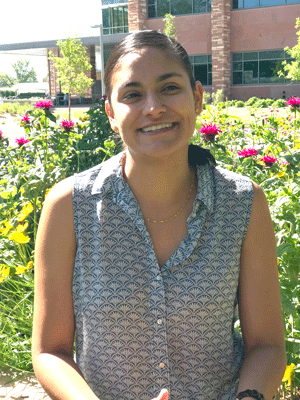Targeting Weed Seeds at Harvest

As herbicide-resistant weeds become more common across the country, researchers and growers are looking for other ways to control weeds.
In Colorado, they’re looking to techniques and technology developed in Australia, which has significant issues with herbicide-resistant weeds.
Known as harvest weed-seed control, these IPM-friendly methods are designed to destroy or remove weed seeds during harvest to prevent them from raining down onto the soil and replenishing the weed seed bank. In Colorado wheat, weed species of concern are winter annual grasses that share the grain’s growing cycle, like jointed goatgrass, feral rye and downy brome.
“In harvest weed-seed control, the objective is to prevent those seed-bank increases,” explained Colorado State University doctoral candidate Neeta Soni. “There are a number of ways to do it, and we’re investigating to see if they could be adopted in Colorado.”
One way to destroy the weeds seeds is by directing chaff during harvest into a cage mill – imagine a giant coffee grinder – and pulverizing the chaff and weed seeds into powder. That’s the idea behind an Australian innovation known as the Harrington Seed Destructor (and a new competitor called the Seed Terminator).
Another option is to use a piece of equipment called a chaff deck to gather chaff into mounded strips behind the harvester, capturing the weed seed in those mounds of chaff. In some places those chaff strips can be burned, and in others they’re left alone to allow the weed seeds to decay without entering the soil.
A third option is to use chaff carts and collect all the chaff and captured weed seeds for off-site destruction.
 “Our research is focused on finding out if there is potential to use these methods in Colorado,” explained Soni, a graduate student of assistant professor Todd Gaines. “So what we needed to know is whether, at harvest, the majority of the winter annual grass seeds are retained in the upper wheat canopy, where they would be vulnerable to the seed destructor or other methods.”
“Our research is focused on finding out if there is potential to use these methods in Colorado,” explained Soni, a graduate student of assistant professor Todd Gaines. “So what we needed to know is whether, at harvest, the majority of the winter annual grass seeds are retained in the upper wheat canopy, where they would be vulnerable to the seed destructor or other methods.”
If the weed seeds have already shattered and fallen to the soil, or if the weed seeds are below the cutting height of the combine, the methods would not be as effective.
So the Weed Research Lab team measured and counted a lot of weeds.
“What we found is that the majority of seeds are still retained at harvest,” Soni said. “Downy brome is the same height as wheat, rye is taller and jointed goatgrass a little shorter, but growers could adjust their cut height to manage it.”
Soni then counted out 1,000 seeds of each weed species into a specified amount of chaff and drove to the University of Arkansas where they have a seed destructor set up on a test platform. She ran each bundle through the destructor. The pulverized material was dusted across beds of soil to see if any weed seeds germinated. Virtually none did.
“The seed destructor was 98 percent effective on downy brome and jointed goatgrass, and 99 percent effective on feral rye,” Soni said.
The Gaines lab hopes to conduct field trials with the equipment. They will also study if the strips of mounded chaff are effective in Colorado, or if the state’s dry and windy conditions enable weed seeds to survive and spread.
The seed destructor isn’t commercially available in the United States yet, but a number of researchers are testing versions in different regions and in different crops. The initial model was a tow-behind trailer, but both Australian manufacturers now offer the technology integrated into a combine harvester that retails between $120,000 and $160,000 Australian dollars.
Not every grower would need to buy one.
“It is very common that growers here have their harvesting done by a contractor,” Soni said, “so this could be an extra service they provide.”
But not at every harvest. Because whatever specific iteration of harvest weed-seed control Colorado growers may eventually adopt, it should be just one element of an integrated management strategy, Soni cautioned.
“Repeated use could lead to the selection of earlier-shattering weed seeds, or shorter weeds,” she said. “It has to be used in rotation with other integrated measures, including herbicides and crop rotation.”
In short, it should be part of an IPM program.